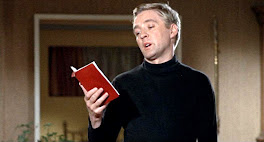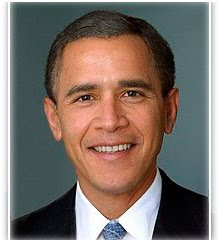Governor David Paterson will announce his choice to succeed Hilary Clinton in the junior U.S. senate seat in New York State, tomorrow, Friday, at 10 AM. Eastern Standard Time.
As anyone who has noticed the news in the last twenty-four hours, the choice will not be Caroline Kennedy. A Paterson administration source has revealed that Paterson had never seriously considered her.

Thursday, January 22, 2009
Wednesday, January 21, 2009
NEWSFLASH! Lady Caroline Kennedy drops out!!!
Lady Caroline, Kennedy Duchess of the Hamptons and Hyannis, has withdrawn. The aristocrat cited "personal reasons" for her withdrawal. (The New York Times, The New York Post and MSNBC are among the sources for this story.)
Who is the front-running now? -Andrew Cuomo, the New York State Attorney General son of the former governor, Mario Cuomo. Yes, he is another political dynasty member. But he does have a full resume, as opposed to a nearly empty one (as in Lady Caroline), and has a public record of his policy positions (again, unlike the mystery surrounding Lady Caroline, until gave a public response to a limited number of questions.
Who deserves Hilary Clinton's former senate seat? One of the most qualified and having true liberal bona fides: Carolyn Maloney. Maloney has a sound record on lunch bucket issues of working families of New York State (specifically, representing parts of Manhattan and Queens).
A superimpressive progressive would be former Congresswoman Liz Holtzman (representing Brooklyn and Queens from 1973 to 1981). Holtzman more recently is remembered as a former district attorney of Kings County (more widely known as Brooklyn).
Alas, it is quite likely that Gov. David Paterson will give the seat to Cuomo. It would behoove him to appoint Cuomo, so as to eliminate a major opponent to his 2010 election campaign.
Who is the front-running now? -Andrew Cuomo, the New York State Attorney General son of the former governor, Mario Cuomo. Yes, he is another political dynasty member. But he does have a full resume, as opposed to a nearly empty one (as in Lady Caroline), and has a public record of his policy positions (again, unlike the mystery surrounding Lady Caroline, until gave a public response to a limited number of questions.
Who deserves Hilary Clinton's former senate seat? One of the most qualified and having true liberal bona fides: Carolyn Maloney. Maloney has a sound record on lunch bucket issues of working families of New York State (specifically, representing parts of Manhattan and Queens).
A superimpressive progressive would be former Congresswoman Liz Holtzman (representing Brooklyn and Queens from 1973 to 1981). Holtzman more recently is remembered as a former district attorney of Kings County (more widely known as Brooklyn).
Alas, it is quite likely that Gov. David Paterson will give the seat to Cuomo. It would behoove him to appoint Cuomo, so as to eliminate a major opponent to his 2010 election campaign.
Saturday, January 17, 2009
Obama, the trains, and race / why it matters where Amtrak is sold out / OBAMA TRAINS INTO DC
WHERE AMTRAK IS SOLD OUT or NOT
As of earlier this afternoon the only trains today, Saturday, to Washington, DC, from points north on the Northeast Corridor (e.g., Baltimore, Philadelphia, New York City, Boston) were evening trains, particularly the uber-expensive Acela train.
By 5 PM, all the trains were sold out. (Sunday and Monday departures were already sold out by early this afternoon; return trips only become available again on Wednesday, aside from a red eye wee hour AM departure.)
The pattern for trains from Pittsburgh, on the Cumberland route, is that there were seats available earlier today for Saturday. Sunday and Monday are sold out. One needs to wait til Thursday for a return trip. (Return trips are sold out.)
Now, to the interesting stuff:
Tickets from seemingly all points south, on the various lines from North Carolina and Virginia, are available on several itineraries (Sunday, Monday trips; returns on a range of days).
(A little bit of an exception: The Crescent, from the trajectory from New Orleans -Atlanta, Charlotte- is sold out for Monday, but tickets are available, folks, for Sunday. Return trips on the 20th and the 21st are sold out, but the 22nd is available.)
This is the old South, remember folks? While we have Obama-mania in the Northeast, enthusiasm is cooler in the South, by this measure. A sad statement, that this is still a divided country.
CONTRAST AGAINST PLESSY
Plessy vs. Ferguson was the Supreme Court decision in the 1890s, sanctioning segregation. The case was concerned with a black passenger and a railroad train. And it was not until the years between 1946 and 1950 that the Court struck down segregation on trains.
Could Obama, as an ordinary citizen, in the early 1940s, make the inauguration train itinerary to Washington, without restrictions?
So, there is additional special significance in Barack Obama's presidential inauguration and his train trip this weekend.
*INAUGURATION TRAIN, AND THE MEDIA REPORTS*
*CNN's interactive map of Obama's "Whistlestop tour."
*Dispatches from Candy Crowley and other CNN correspondents along the route.
*Obama had "ordinary folks" as guests, 51 guests, this included 16 families from 15 states.
*By mid-afternoon, Obama and family, and Joe Biden, arrived in Washington, D.C.'s Union Station.
(The NY Times report.)
As of earlier this afternoon the only trains today, Saturday, to Washington, DC, from points north on the Northeast Corridor (e.g., Baltimore, Philadelphia, New York City, Boston) were evening trains, particularly the uber-expensive Acela train.
By 5 PM, all the trains were sold out. (Sunday and Monday departures were already sold out by early this afternoon; return trips only become available again on Wednesday, aside from a red eye wee hour AM departure.)
The pattern for trains from Pittsburgh, on the Cumberland route, is that there were seats available earlier today for Saturday. Sunday and Monday are sold out. One needs to wait til Thursday for a return trip. (Return trips are sold out.)
Now, to the interesting stuff:
Tickets from seemingly all points south, on the various lines from North Carolina and Virginia, are available on several itineraries (Sunday, Monday trips; returns on a range of days).
(A little bit of an exception: The Crescent, from the trajectory from New Orleans -Atlanta, Charlotte- is sold out for Monday, but tickets are available, folks, for Sunday. Return trips on the 20th and the 21st are sold out, but the 22nd is available.)
This is the old South, remember folks? While we have Obama-mania in the Northeast, enthusiasm is cooler in the South, by this measure. A sad statement, that this is still a divided country.
CONTRAST AGAINST PLESSY
Plessy vs. Ferguson was the Supreme Court decision in the 1890s, sanctioning segregation. The case was concerned with a black passenger and a railroad train. And it was not until the years between 1946 and 1950 that the Court struck down segregation on trains.
Could Obama, as an ordinary citizen, in the early 1940s, make the inauguration train itinerary to Washington, without restrictions?
So, there is additional special significance in Barack Obama's presidential inauguration and his train trip this weekend.
*INAUGURATION TRAIN, AND THE MEDIA REPORTS*
*CNN's interactive map of Obama's "Whistlestop tour."
*Dispatches from Candy Crowley and other CNN correspondents along the route.
*Obama had "ordinary folks" as guests, 51 guests, this included 16 families from 15 states.
*By mid-afternoon, Obama and family, and Joe Biden, arrived in Washington, D.C.'s Union Station.
(The NY Times report.)
Thursday, January 15, 2009
Birds collide with jet / plane lands on water / preflight safety lessons relevant
MSNBC reported that a flock of geese went into the intake engine of US Airways 1549, causing at least one engine to fail. (The flight was from LaGuardia Airport, heading to Charlotte, the largest city in North Carolina.)
One passenger, interviewed on WNBC-TV, said that he saw left engine burn up. Recent reports say that both engines blew out. (PopSci.Com: "Explaining the US Airways Crash")
The engines went out too soon for the pilot to guide the flight to an airport at Teterboro, in that other state, New Jersey. Accordingly, the pilot turned the plane southward, to steer into the Hudson River. Given the rapidly falling altitude, the plane missed the George Washington Bridge by 900 feet.
The pilot guided the flight to the Hudson River, roughly at the latitude of 48th Street. Fortunately, all of the 150 passengers were able to take rescue rafts and reach land alive.
WCBS-TV reports that the moment that birds pose the greatest to planes is right at take-off.
* * *
Well, this proves that it is worth putting down the Sky Mall magazine and paying attention to the safety directions.
* * *
We are awaiting former mayor Rudy Giuliani's accusing the birds of ties to Al-Qaeda.
UPDATE:
From democraticunderground:
"Please note airlines are trying to get rid of older pilots that make more. This is a great reason to keep the experienced pilots where they belong, in the pilots seat!"
DU post linked to this opinion piece on Examiner.com.
One passenger, interviewed on WNBC-TV, said that he saw left engine burn up. Recent reports say that both engines blew out. (PopSci.Com: "Explaining the US Airways Crash")
The engines went out too soon for the pilot to guide the flight to an airport at Teterboro, in that other state, New Jersey. Accordingly, the pilot turned the plane southward, to steer into the Hudson River. Given the rapidly falling altitude, the plane missed the George Washington Bridge by 900 feet.
The pilot guided the flight to the Hudson River, roughly at the latitude of 48th Street. Fortunately, all of the 150 passengers were able to take rescue rafts and reach land alive.
WCBS-TV reports that the moment that birds pose the greatest to planes is right at take-off.
* * *
Well, this proves that it is worth putting down the Sky Mall magazine and paying attention to the safety directions.
* * *
We are awaiting former mayor Rudy Giuliani's accusing the birds of ties to Al-Qaeda.
UPDATE:
From democraticunderground:
"Please note airlines are trying to get rid of older pilots that make more. This is a great reason to keep the experienced pilots where they belong, in the pilots seat!"
DU post linked to this opinion piece on Examiner.com.
Labels:
bird strike,
Hudson River,
US Airways 1549,
water landing
Tuesday, January 13, 2009
The Green case against rail trails; trains leading in fuel efficiency
Now, let me open with a disclaimer:
I am not against walking or biking along these trails. Years back, I hiked with some friends along a decommissioned train line. And I have fond memories of viewing the countryside, without roads and cars coming at us.
My peeve is this:
Rail trails represent the death of rails. They send the message that rails are things of the past.
Instead, we should look into renewing train service along defunct, decommissioned lines. Rail trails could remain, with the paths adjacent to the trails.
We should keep in mind the green benefits of train transportation over other modes of transportation.
Rail freight is more fuel efficient that trucks are. Estimates of rail fuel efficiency rates range from 423 tons of material on one gallon of fuel
to 436 miles per gallon of fuel. Rail traffic has an efficiency rate three times that of trucks. (Admittedly, these are from rail industry sources.)
(Another site: rail freight shipping is eight times more energy efficient than truck shipping.)
Indeed, the Annenberg Foundation's FactCheck.org supports this claim. The following is from their site on this issue:
Q: Can a freight train really move a ton of freight 436 miles on a gallon of fuel?
A: Yes, and some do even better. The figure used in the rail industry's advertising is a national average.
This question is generated by an advertising campaign by the railroad industry, which is arguing that a good way to reduce greenhouse gas emissions is to move more freight by rail rather than by truck. An example of the industry's ads can be seen on the Web site www.freightrailworks.org.
We'll remain neutral in the perpetual competition between the railroad industry and the truckers, about which we'll say more later in this article. But we can vouch for the 436-mile claim. It's the average for all major U.S. railroads for 2007.
Each year the railroads are required to submit reports to the federal Surface Transportation Board, the regulatory body that took over some of the functions of the old Interstate Commerce Commission. The annual reports of each railroad are public information, available on the STB's Web site. Buried amid all the facts about the number of railroad ties replaced, cubic yards of ballast placed and the cost of new locomotives, the railroads also report totals for the number of gallons of diesel fuel consumed and tons of freight moved. The government doesn't tally up those figures anymore, but the Association of American Railroads does. And now, we have done the same.
According to our calculations, which match the AAR's tally exactly, the nation's seven major railroad companies reported the following for 2007:
* Moving 1,770,545,245,000 ton-miles of freight
* Consuming 4,062,025,082 gallons of diesel fuel (including freight trains and trains in switching yards, but excluding passenger trains)
The average works out to be 435.88 ton-miles per gallon of fuel.
Some rail lines do better. The Soo Line, which is the U.S. branch of the Canadian Pacific, operating in the upper Midwest, reported moving each ton of freight 517.8 miles per gallon of diesel fuel, on average. Lines operated by the Grand Trunk Corp. reported 510.5 ton-miles per gallon.
The national average figure of 436 miles is the highest on record, according to AAR, and a 3.1 percent increase from the 423-mile figure reached in 2006.
The rail industry says its fuel efficiency has increased by 85 percent since 1980. It attributes that to factors that include using new and more efficient locomotives, training engineers to conserve fuel, using computers to assemble trains more efficiently in the yard and to plan trips more efficiently to avoid congestion, and reducing the amount of time engines are idling.
The same holds true for comparing passenger-per mile fuel consumption with buses or planes.
I am not against walking or biking along these trails. Years back, I hiked with some friends along a decommissioned train line. And I have fond memories of viewing the countryside, without roads and cars coming at us.
My peeve is this:
Rail trails represent the death of rails. They send the message that rails are things of the past.
Instead, we should look into renewing train service along defunct, decommissioned lines. Rail trails could remain, with the paths adjacent to the trails.
We should keep in mind the green benefits of train transportation over other modes of transportation.
Rail freight is more fuel efficient that trucks are. Estimates of rail fuel efficiency rates range from 423 tons of material on one gallon of fuel
to 436 miles per gallon of fuel. Rail traffic has an efficiency rate three times that of trucks. (Admittedly, these are from rail industry sources.)
(Another site: rail freight shipping is eight times more energy efficient than truck shipping.)
Indeed, the Annenberg Foundation's FactCheck.org supports this claim. The following is from their site on this issue:
Q: Can a freight train really move a ton of freight 436 miles on a gallon of fuel?
A: Yes, and some do even better. The figure used in the rail industry's advertising is a national average.
This question is generated by an advertising campaign by the railroad industry, which is arguing that a good way to reduce greenhouse gas emissions is to move more freight by rail rather than by truck. An example of the industry's ads can be seen on the Web site www.freightrailworks.org.
We'll remain neutral in the perpetual competition between the railroad industry and the truckers, about which we'll say more later in this article. But we can vouch for the 436-mile claim. It's the average for all major U.S. railroads for 2007.
Each year the railroads are required to submit reports to the federal Surface Transportation Board, the regulatory body that took over some of the functions of the old Interstate Commerce Commission. The annual reports of each railroad are public information, available on the STB's Web site. Buried amid all the facts about the number of railroad ties replaced, cubic yards of ballast placed and the cost of new locomotives, the railroads also report totals for the number of gallons of diesel fuel consumed and tons of freight moved. The government doesn't tally up those figures anymore, but the Association of American Railroads does. And now, we have done the same.
According to our calculations, which match the AAR's tally exactly, the nation's seven major railroad companies reported the following for 2007:
* Moving 1,770,545,245,000 ton-miles of freight
* Consuming 4,062,025,082 gallons of diesel fuel (including freight trains and trains in switching yards, but excluding passenger trains)
The average works out to be 435.88 ton-miles per gallon of fuel.
Some rail lines do better. The Soo Line, which is the U.S. branch of the Canadian Pacific, operating in the upper Midwest, reported moving each ton of freight 517.8 miles per gallon of diesel fuel, on average. Lines operated by the Grand Trunk Corp. reported 510.5 ton-miles per gallon.
The national average figure of 436 miles is the highest on record, according to AAR, and a 3.1 percent increase from the 423-mile figure reached in 2006.
The rail industry says its fuel efficiency has increased by 85 percent since 1980. It attributes that to factors that include using new and more efficient locomotives, training engineers to conserve fuel, using computers to assemble trains more efficiently in the yard and to plan trips more efficiently to avoid congestion, and reducing the amount of time engines are idling.
The same holds true for comparing passenger-per mile fuel consumption with buses or planes.
Subscribe to:
Posts (Atom)















